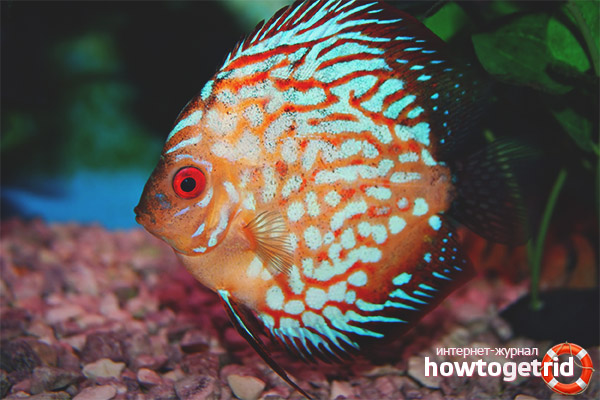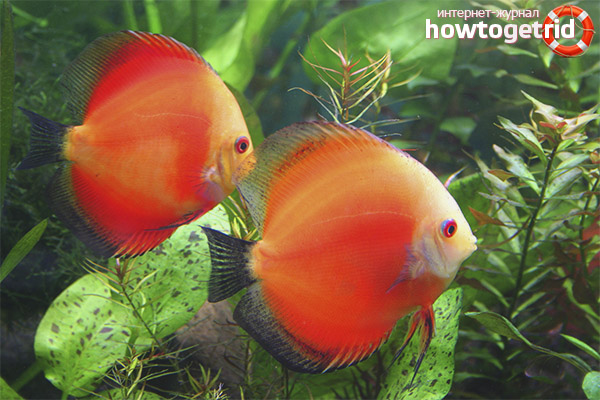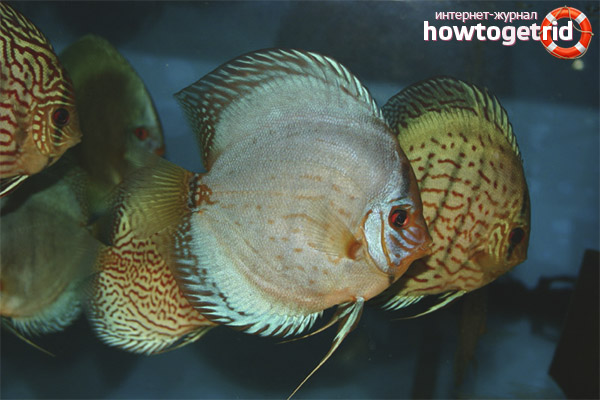The content of the article
Aquarium fish discus has an original body shape, as well as a very beautiful color. Fans of aquariums call them real kings among other inhabitants of the freshwater aquarium. These fish are quite large, have a bright color. Representatives of the species can have many colors. They behave in a measured and majestic manner, as befits a real royal. They have a peaceful character and special elegance, thanks to which they stand out among other fish and always attract the eye of the observer.
Discus is classified as cichlid. There are three subspecies of these fish. Two species are known to aquarists for quite some time, and one of them was discovered quite recently. Two already well-known subspecies are Symphysodon aequifasciatus, as well as Symphysodon discus. They are the most popular.Their natural habitat is the middle and lower part of the Amazon. These varieties are similar. They have a similar color and behave similarly. The third variety has the Latin name Symphysodon haraldi. This fish is called the blue discus. The subspecies described Heiko Bleher. But today he is awaiting confirmation.
Nowadays, wild species of discus are found in nature much less frequently than artificial ones. The derived forms have a very interesting color. But they have a lot of flaws. They are poorly adapted to the conditions of the aquarium, they are ill more, it is necessary to take care of them more carefully and carefully. Discus are expensive fish. Expensive not only their purchase, but also the maintenance. Among all the aquarium fish, they are among the most demanding of conditions. Water parameters for discus should always be at the required level. The aquarium should be spacious and the food should be abundant and of high quality. Therefore, acquiring the discus, you need to think about whether you have enough experience in maintaining the aquarium, whether you find the means and time to properly care for them.
Habitat in nature
These fish come from South America. These are countries such as Peru, Brazil and Colombia. Discus lives both in the Amazon itself and in its tributaries. In the 30s, representatives of this species first appeared in Europe. They had previously tried to bring them to Europe, but the attempts were not crowned with success. Given the previous bad experience, it was still possible to do it. Today in nature you can meet green, red and blue representatives. Let us consider in more detail each species of this fish.
- Green Discus, whose name in Latin sounds like Symphysodon aequifasciatus, was described in 1904 by the scientist Pellegrin. Representatives of the subspecies can be found in the central part of the Amazon. They live in the river Putumayo in Peru, as well as in Lake Tefe, which is located in Brazil.
- Red Discus is also called Heckel Discus. In Latin, the subspecies is called Symphysodon discus. Described these fish John Heckel. Entries are dated 1840 year. These fish live in Rio Negro, which flows through the territory of Brazil.
- Blue discus scientists call Symphysodon haraldi. Schultz described it back in 1960. Their habitat is the lower part of the Amazon. Subtype discovered recently.
Description
These fish are quite large in size. Their body is disk-shaped.At the same time, depending on the subspecies, it can be about 15-25 cm in length. These cichlids are one of the most oblate compared to their other relatives. These fish got their name precisely because of their discoid shape.
To date, a lot of artificial varieties of discus, which differ in a variety of colors. Therefore, it is impossible to say what color these fish have. You can list options for a very long time. The most common colors are leopard, red, yellow, turkis and many others.
But as a result of crossing fish with new colors, they also acquired rather poor health. Immunity is low, so they often get sick. Wild discus is more resistant to disease and changes in external conditions, but in aquariums they can be found less and less.
Content issues

Acquisition of discus is recommended for those aquarists who have already gained considerable experience. Beginners should not buy them. Moreover, the fish is not cheap, and it will be a pity if it dies. Discus care will be a challenge even for experienced aquarium lovers.It’s quite difficult to provide them with the conditions they need. And the breeding of such fish does require a lot of experience and knowledge.
As soon as an aquarist acquires such a fish, but faces the problem of acclimatization. Adults can get used to changing their habitats faster and easier, but even they are under stress.
Problems are also caused by the large size of the fish, weak immunity, and high demands on the conditions and quality of food. In addition, these fish need to keep the water always warm. Before you buy such fish, you must examine all their requirements and prepare to maintain the necessary conditions. It is necessary to purchase a large aquarium, a powerful high-quality filter, high-quality food. Even with everything you need, you will first have to be patient.
Care must be taken when purchasing and transporting. They can get sick with decoy or some other disease due to the fact that they experience stress during the move.
Feeding
The main ration of discus should be animal feed. It can be in live or frozen form.They are suitable tubemaker, artemia, gammarus. But many aquarists feed their discus with a special food developed for fish of this species or with minced meat, which includes many components. It should be minced seafood, beef heart, various vegetables and a complex of vitamins. Everyone who has considerable experience in the maintenance of such fish, has developed his own feeding recipe, which often includes more than 10 components.
In addition, it is important not to forget that these fish are fearful and slow. If they are kept together with other fish, they may not have time to eat food. Therefore, it is desirable to keep them separate.
It is also necessary to take into account that waste from the protein feed remains, which deteriorates and causes an increase in the amount of harmful substances in the water, which is unacceptable for discus. To avoid the accumulation of harmful substances, the bottom must be siphoned regularly. But many experienced aquarists simply do not use any soil.
Live food can cause poisoning or illness in fish. Therefore, they are fed more often with minced meat or ready-made purchased feed.
Content
To contain the discus, you must purchase an aquarium of at least 250 liters. When buying not one, but several such fish, its volume should be 300-400 and more liters. It is important that he was high. Be sure to use a strong filter, constantly siphon the ground and replace the water. It is important that the water was very clean, without ammonia, nitrates. Parameters must be strictly at the proper level.
Fish leave behind not too much food waste, but due to the fact that their food is proteinaceous, it quickly decomposes and begins to pollute the water.
Discussions like water to be acidified, soft. The temperature needed is very warm. Water should be warmer than for many tropical fish. This is a problem, due to which it is extremely difficult to pick up the neighbors for these fish.
In order for the discus to feel good, the water temperature must be 28-31 degrees. Water hardness - 10 -15, and pH - 6-6.5. If the parameters go beyond this, it will lead to illness or death of the fish.
These fish love calm and different timidity. Loud sound, constant movement or strikes on the aquarium will be a real stress for them.It is also impossible to settle overly active neighbors with them. Therefore, the aquarium should be in the most peaceful place.
You can plant in the aquarium with these fish plants. But it is important that at the same time they have a place to swim. It is difficult to choose suitable plants, as many of them will not grow at such a high temperature. You can plant didiplis, ambulia or vallisneria. But these fish are valuable and look good without any decor or vegetation. Professionals do not plant plants in aquariums and do not use soil or decor. This simplifies care and reduces the possibility of disease.
Running the discus in the aquarium after the acquisition, it can not be disturbed for some time. Do not immediately turn on the lights and stand near the aquarium. Fish should move away from stress and get used to. It is advisable to put in the aquarium any object that can serve as a shelter for it. Someone may wonder why people buy such difficult to care and fastidious fish. But those who will take care of them properly will receive a lot of pleasure as a reward.
Compatibility
These fishes are quite peaceful, which distinguishes them from most cichlids. They will not dig the ground or hunt the neighbors. They prefer to live in flocks. One at a time will feel uncomfortable.
Neighbors for them is difficult to choose. After all, they eat quite slowly and love the very high temperature of the water.
Because of this, most often they are kept separately. But you can pick up the neighbors. These can be neons, congos, tarakatums. You can not addicted to them catfish that have a sucker instead of a mouth. Corridors are also not suitable as neighbors, as they are carriers of parasites.
Gender Differences
To determine the floor is not easy. Similarly, one can only say during the spawning period. But experienced amateurs claim that males have a steep forehead, and their lips are thicker than those of females.
Breeding
The female usually lays caviar on decorative elements or plants.Today you can buy a cone that is easy to use. Spawning can occur in fairly hard water. But for the fertilization of caviar, this indicator should be maintained at a level not higher than 6. The pH level should be about 5.5-6. Temperature - 28-31.
Several hundred eggs are laid at a time. After 2.5 days, they will hatch. When fry appear, during the first few days of life they will have a special secret that their parents' skin exudes.
Video: discus fish aquarium













To send